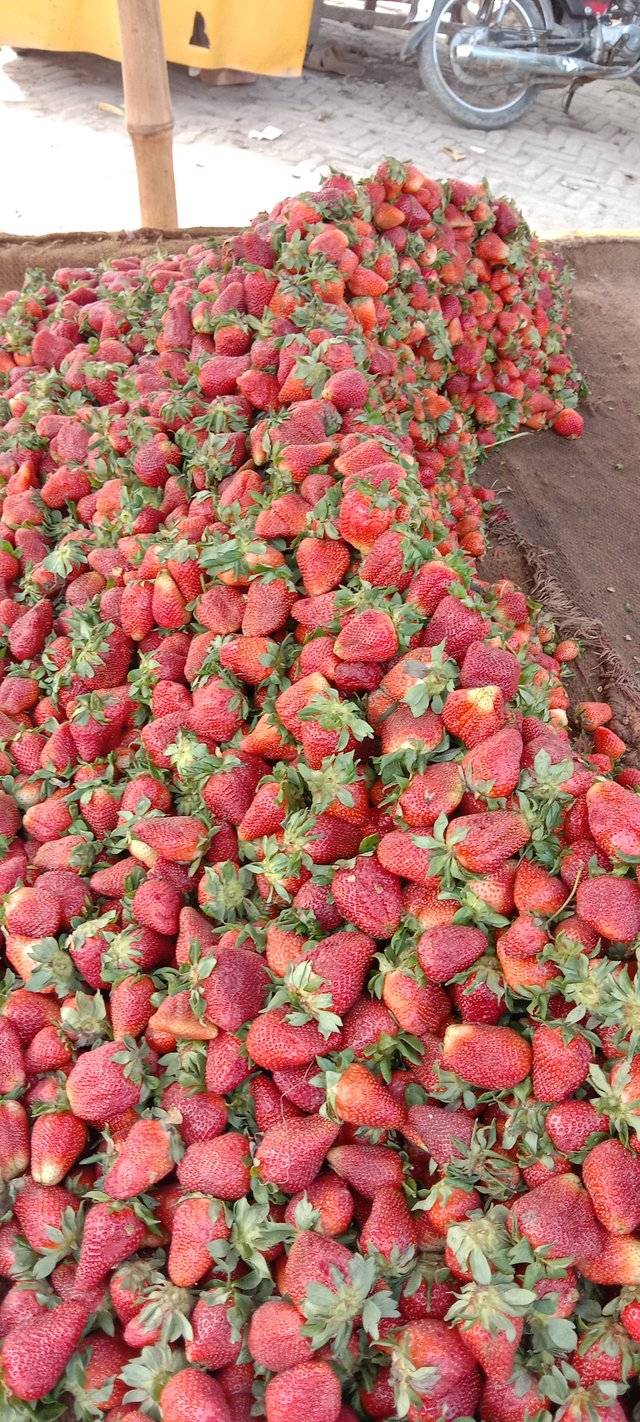Strawberry

The garden strawberry or simply strawberry Fragaria ananassa is a widely grown hybrid species of the genus Fragaria, collectively known as the strawberries, which are cultivated worldwide for their fruit. The fruit is widely appreciated for its characteristic aroma, bright red color, juicy texture, and sweetness. It is consumed in large quantities, either fresh or in such prepared foods as jam, juice, pies, ice cream, milkshakes, and chocolates. Artificial strawberry flavorings and aromas are also widely used in products such as candy, soap, lip gloss, perfume, and many others.
The garden strawberry was first bred in Brittany, France, in the 1750s via a cross of Fragaria virginiana from eastern North America and Fragaria chiloensis, which was brought from Chile by Amédée-François Frézier in 1714. Cultivars of Fragaria ananassa have replaced, in commercial production, the woodland strawberry (Fragaria vesca), which was the first strawberry species cultivated in the early 17th century.
The strawberry is not, from a botanical point of view, a berry. Technically, it is an aggregate accessory fruit, meaning that the fleshy part is derived not from the plant's ovaries but from the receptacle that holds the ovaries. Each apparent "seed" (achene) on the outside of the fruit is actually one of the ovaries of the flower, with a seed inside it.
growth
Strawberry flower
.jpeg)
Pollen grains of strawberry
Strawberries are often grouped according to their flowering habit.Traditionally, this has consisted of a division between "June-bearing" strawberries, which bear their fruit in the early summer and "ever-bearing" strawberries, which often bear several crops of fruit throughout the season.One plant throughout a season may produce 50 to 60 times or roughly once every three days.
Research published in 2001 showed that strawberries actually occur in three basic flowering habits: short-day, long-day, and day-neutral. These refer to the day-length sensitivity of the plant and the type of photoperiod that induces flower formation. Day-neutral cultivars produce flowers regardless of the photoperiod.
Cultivation
Strawberry cultivars vary widely in size, color, flavor, shape, degree of fertility, season of ripening, liability to disease and constitution of plant. On average, a strawberry has about 200 seeds on its external membrane.Some vary in foliage, and some vary materially in the relative development of their sexual organs. In most cases, the flowers appear hermaphroditic in structure, but function as either male or female.
For purposes of commercial production, plants are propagated from runners and, in general, distributed as either bare root plants or plugs. Cultivation follows one of two general models—annual plasticulture, or a perennial system of matted rows or mounds.Greenhouses produce a small amount of strawberries during the off season.
The bulk of modern commercial production uses the plasticulture system. In this method, raised beds are formed each year, fumigated, and covered with plastic to prevent weed growth and erosion. Plants, usually obtained from northern nurseries, are planted through holes punched in this covering, and irrigation tubing is run underneath. Runners are removed from the plants as they appear, to encourage the plants to put most of their energy into fruit development.
After harvesting, the plastic is removed and the plants are plowed into the ground.Strawberry plants produce more and better fruit when they are young. After a year or two, they decline. Replacing them annually improves yields and enables denser planting.However, this necessitates a longer growing season, for the plants to establish themselves. It also costs more to annually purchase plants, form new mounds, and cover them with (new) plastic.
Manuring and harvesting
.jpeg)
Most strawberry plants are now fed with artificial fertilizers, both before and after harvesting, and often before planting in plasticulture.
To maintain top quality, berries are harvested at least every other day. The berries are picked with the caps still attached and with at least half an inch of stem left. Strawberries need to remain on the plant to fully ripen because they do not continue to ripen after being picked. Rotted and overripe berries are removed to minimize insect and disease problems. The berries do not get washed until just before consumption
Soil test information and plant analysis results are used to determine fertility practices. Nitrogen fertilizer is needed at the beginning of every planting year. There are normally adequate levels of phosphorus and potash when fields have been fertilized for top yields. To provide more organic matter, a cover crop of wheat or rye is planted in the winter before planting the strawberries. Strawberries prefer a pH from 5.5 to 6.5, so lime is usually not applied.
The harvesting and cleaning process has not changed substantially over time. The delicate strawberries are still harvested by hand.Grading and packing often occurs in the field, rather than in a processing facility. In large operations, strawberries are cleaned by means of water streams and shaking conveyor belts.
Nutrients
Raw strawberries are 91% water, 8% carbohydrates, 1% protein, and contain negligible fat (table). A 100 gram reference amount of strawberries supplies 33 kilocalories, is a rich source of vitamin C (71% of the Daily Value, DV), a good source of manganese (18% DV), and provides several other vitamins and dietary minerals in small amounts. Strawberries contain a modest amount of essential unsaturated fatty acids in the achene (seed) oil
Thankx for visting my post
Hello @mumar,
Welcome to the Steemit Nursery family! We are pleased to onboard you as a #Alumni in our community.
Have a pleasant stay in Steemit Nursery Community, Thank you! 💐
Best regards,
Steemit Nursery Team
#affable
Downvoting a post can decrease pending rewards and make it less visible. Common reasons:
Submit